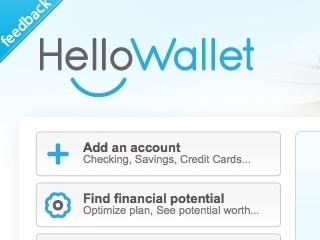 Three years ago, the notion of giving a web startup your credit card and bank account login details was generally considered ludricous, given the rising trend of identify theft. So thought some investors who turned down the opportunity to invest in Mint.com, a site that today helps millions of people manage their assets, and sold last year to Intuit for $140 million.
Three years ago, the notion of giving a web startup your credit card and bank account login details was generally considered ludricous, given the rising trend of identify theft. So thought some investors who turned down the opportunity to invest in Mint.com, a site that today helps millions of people manage their assets, and sold last year to Intuit for $140 million.
The notion is not so ludricous today, and a number of investors are betting the market is still wide open. Personal finance software HelloWallet has raised a $3.6 million Series A round of funding from veteran venture capital firm Grotech Ventures and AOL cofounder Steve Case.
The company is very similar to Mint: users enter their bank account information, and HelloWallet offers guidance on tracking budgets, financial planning and ways to save money. The main difference is in revenue model: whereas Mint is free and makes money from advertising deals with banks, HelloWallet charges a $5/ month subscription fee, and remains independent from banks. “Unlike most free financial service sites, we do not accept any money from banks or brokerages to peddle products,” CEO Matt Fellowes told VatorNews, “so we’re completely unbiased about where people bank.”
That might give users more piece of mind when they see recommendations to switch their checking, credit card, or investment accounts to another vendor.
I signed up for a free account and entered all my bank information. The signup took about the same time as Mint–15 minutes. It has very similar savings recommendations to Mint, with a few noticeably differences. Mint’s suggested savings for switching to a different bank were slightly higher than HelloWallet’s [update: Mint’s savings are estimated over three years, and HelloWallet’s are annual, so HelloWallet’s are actually significantly better], and the first three recommendations were sponsored–a fact I hadn’t noticed the first few times I browsed the results, since the only indication of it being sponsored is a subtle stripe on the corner of the recommendation. Still, those recommendations seemed to be better than the non-sponsored results, suggesting that Mint’s relationships with banks could work in favor of consumers–it seems Mint is able to attract special deals with its leverage.
One HelloWallet feature I liked was the “potential savings at your bank”–a figure that I couldn’t find on Mint. Like many consumers, I’m leary of switching banks merely because of the hassle involved, but I do like to know whether I have the best checking and savings option at my own bank. Even though HelloWallet says there are $0 in potential savings at my own bank, that’s useful info–it puts my mind at rest.
The HelloWallet team has a history in consumer finance advocacy, which bodes well for its branding. The company says it has 3.5 million customers, and many of those come through deals with organizations, as opposed to individual signups.
HelloWallet is based in Washington DC, and has attracted accolades from some high-profile people including Bill Clinton and the Rockefeller Foundation.
Update: CEO Matt Fellowes responded to some questions via email:
MB: It looks like HelloWallet’s strategic difference vis-a-vis Mint is that it doesn’t allow advertising or promotion from banks. Are there other differences?
MF: 1. Prospective financial guidance. Other money management sites look through the rear view mirror of people’s finances, analyzing how they spent their money in the past. We do that, too, but our focus is looking through the windshield of someone’s finances and proactively identifying savings opportunities, financial health threats, and the optimal steps they need to take to maximize their wealth.
2. Charitable mission. We give away one from subscription for every five paying subscribers to a needy family, a commitment that was honored by President Clinton at the 2009 Clinton Global Initiative.
3. Robust market data. We have powerful analytics and market data that have never been available before to consumers, including a paycheck allocation service, the tuition of every post-secondary school in the country, a home value forecasting service. We have access to that data.
4. Distributional channels. Our primary focus to date has been on providing institutions with access to HelloWallet, including employers that provide HW as a benefit, utilities that promote our service as a risk management tool, and so on. That is where most of our development has occurred to date, although we will be turning our attention directly to consumers in the next 12 months.
5. Independence. Unlike most free financial service sites, we do not accept any money from banks or brokerages to peddle products, so we’re completely unbiased about where people bank.
MB: TechCrunch reports you’re partnering with institutions, like Ernst & Young. Do you expect most of your business to come through such partnerships (as opposed to individual sign-ups)? How do these partnerships work?
MF: In the near term, we expect that most of our business will come through partnerships, although we do plan in the next 12 months to more aggressively pursue the direct to consumer market. Here are a couple examples of our deals to date:
– Ernst & Young. They are one of the top 3 provides of financial guidance benefits that employers subsidize for their workforce and have selected HelloWallet as an online solution to complement their call-center based solution. That will begin rolling out to their existing employer customers later in the summer.
– City of San Francisco. On March 9, 2010, Mayor Gavin Newsom and Treasurer Jose Cisneros of San Francisco announced that the city would become the first in the country to provide financial guidance to all of its residents–a solution provided by HelloWallet. We are partnering with a broad range of institutions in the city of San Francisco to distribute our service to the residents of San Francisco. That includes the Chamber of Commerce, Pacific Gas & Electric, Laborers Union, Walter & Elise Haas Fund, Levi Strauss Foundation, San Francisco Public Utility Commission, and EARN. These partners will help promote access to HelloWallet to their employees, customers, members, or partner organizations starting later this month.
MB: Do you have any insight as to how Mint’s relationship with banks could taint recommendations, ultimately disadvantage users?
MF: It’s really all of the free sites out there with a business model that peddles products for banks and other financial institutions – Mint is one of the more high profile, but there are literally hundreds out there. More will be forthcoming, but in the meantime here is some modest evidence we presented last fall: http://www.businessweek.com/investor/content/sep2009/pi20090929_616550.htm (look on the last page).

















